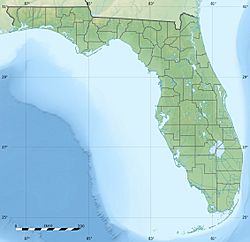Palm Key facts for kids
| Geography | |
|---|---|
| Location | Gulf of Mexico |
| Coordinates | 25°05′34″N 80°52′47″W / 25.092773°N 80.879795°W |
| Archipelago | Florida Keys |
| Adjacent bodies of water | Florida Straits |
| Administration | |
| State | Florida |
| County | Monroe |
Palm Key is a small, quiet island located in a part of the Gulf of Mexico called Florida Bay. It's found near the southern tip of Florida, about 3 miles (or 5 kilometers) southeast of a town called Flamingo.
This island is shaped like a small oval and is about 0.5 miles (or 0.8 kilometers) long. It's known for being uninhabited, which means no people live there permanently. It's a natural spot, often visited by wildlife.
Contents
Where is Palm Key?
Palm Key is part of the amazing Florida Keys, a chain of islands that stretch off the coast of Florida. It sits in Florida Bay, which is a shallow body of water connected to the Straits of Florida. These straits are a channel of water that links the Gulf of Mexico to the Atlantic Ocean.
Location Details
- Coordinates: Palm Key is located at about 25°7'N latitude and 80°53'W longitude. These numbers help pinpoint its exact spot on a map.
- Nearby Town: The closest town is Flamingo, Florida. It's a small community known as a gateway to Everglades National Park.
- Water Bodies: The island is surrounded by the waters of Florida Bay, which are part of the larger Gulf of Mexico.
What is an Uninhabited Island?
An uninhabited island is a piece of land surrounded by water where no humans live. These islands are often wild and untouched by human development. They can be important homes for many different kinds of plants and animals.
Why are some islands uninhabited?
Islands might be uninhabited for several reasons:
- Size: They might be too small to support a community.
- Freshwater: They might not have enough fresh drinking water.
- Accessibility: They could be hard to reach, with no easy way to build roads or docks.
- Protection: Some islands are protected nature reserves, meaning people are not allowed to live there to keep the environment safe for wildlife.
Palm Key is a great example of a natural, uninhabited island, offering a glimpse into Florida's wild side.



